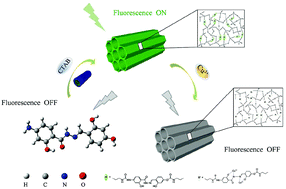An “off–on–off” fluorescence chemosensor for the sensitive detection of Cu2+ in aqueous solution based on multiple fluorescence emission mechanisms†
Abstract
A new organosiloxane precursor ((E)-3-hydroxy-4-((2-(2-hydroxy-4-(3-(3-(triethoxysilyl)propyl)ureido)benzoyl)hydrazono)methyl)phenyl(3-(triethoxysilyl)propyl)carbamate, hereinafter referred to as AHBH-Si) and tetraethylorthosilicate (TEOS) were mixed as the mixed Si source, and bridged periodic mesoporous organic silica (AHBH-PMOs) nanoparticles were obtained through the co-condensation reaction. AHBH-PMO nanoparticles possess mechanisms of “Aggregation Induced Emission” (AIE) and “Intramolecular Charge Transfer” (ICT), which originate from the molecular structure of AHBH having “C![[double bond, length as m-dash]](https://www.rsc.org/images/entities/char_e001.gif) N” bond, ortho hydroxyl groups, etc.. Therefore, the optical properties of AHBH are excellent with respect to the solvent effect and enhanced fluorescence. For hybrid materials, the silica framework provides a rigid environment that restricts the rotation of AHBH, thereby turning on the fluorescence of AHBH due to the regulation by the AIE effect. In particular, AHBH-PMOs are no longer restricted by organic solvents and could really achieve the response to Cu2+ with high sensitivity and selectivity in aqueous solutions of a wide pH range. In addition, the detection limit is as low as 3.26 × 10−9 M. Methods such as Fourier transform infrared spectroscopy, proton nuclear magnetic resonance spectroscopy, and high-resolution mass spectrometry have shown the coordination interaction between AHBH and Cu2+. The Gaussian 09 software of density functional theory to calculate the reducing changes of energy gaps among AHBH and AHBH-Si before and after the addition of Cu2+ showed that coordination interaction exists in the system. These results indicate that AHBH-PMO hybrid materials have potential applications in the field of environmental monitoring.
N” bond, ortho hydroxyl groups, etc.. Therefore, the optical properties of AHBH are excellent with respect to the solvent effect and enhanced fluorescence. For hybrid materials, the silica framework provides a rigid environment that restricts the rotation of AHBH, thereby turning on the fluorescence of AHBH due to the regulation by the AIE effect. In particular, AHBH-PMOs are no longer restricted by organic solvents and could really achieve the response to Cu2+ with high sensitivity and selectivity in aqueous solutions of a wide pH range. In addition, the detection limit is as low as 3.26 × 10−9 M. Methods such as Fourier transform infrared spectroscopy, proton nuclear magnetic resonance spectroscopy, and high-resolution mass spectrometry have shown the coordination interaction between AHBH and Cu2+. The Gaussian 09 software of density functional theory to calculate the reducing changes of energy gaps among AHBH and AHBH-Si before and after the addition of Cu2+ showed that coordination interaction exists in the system. These results indicate that AHBH-PMO hybrid materials have potential applications in the field of environmental monitoring.



 Please wait while we load your content...
Please wait while we load your content...